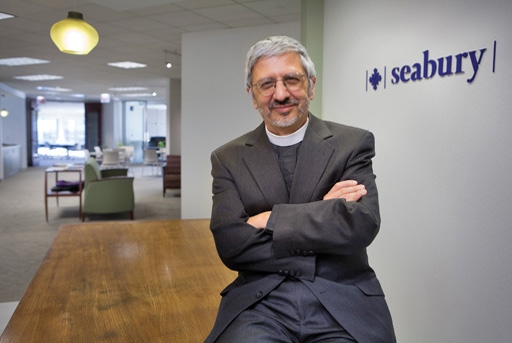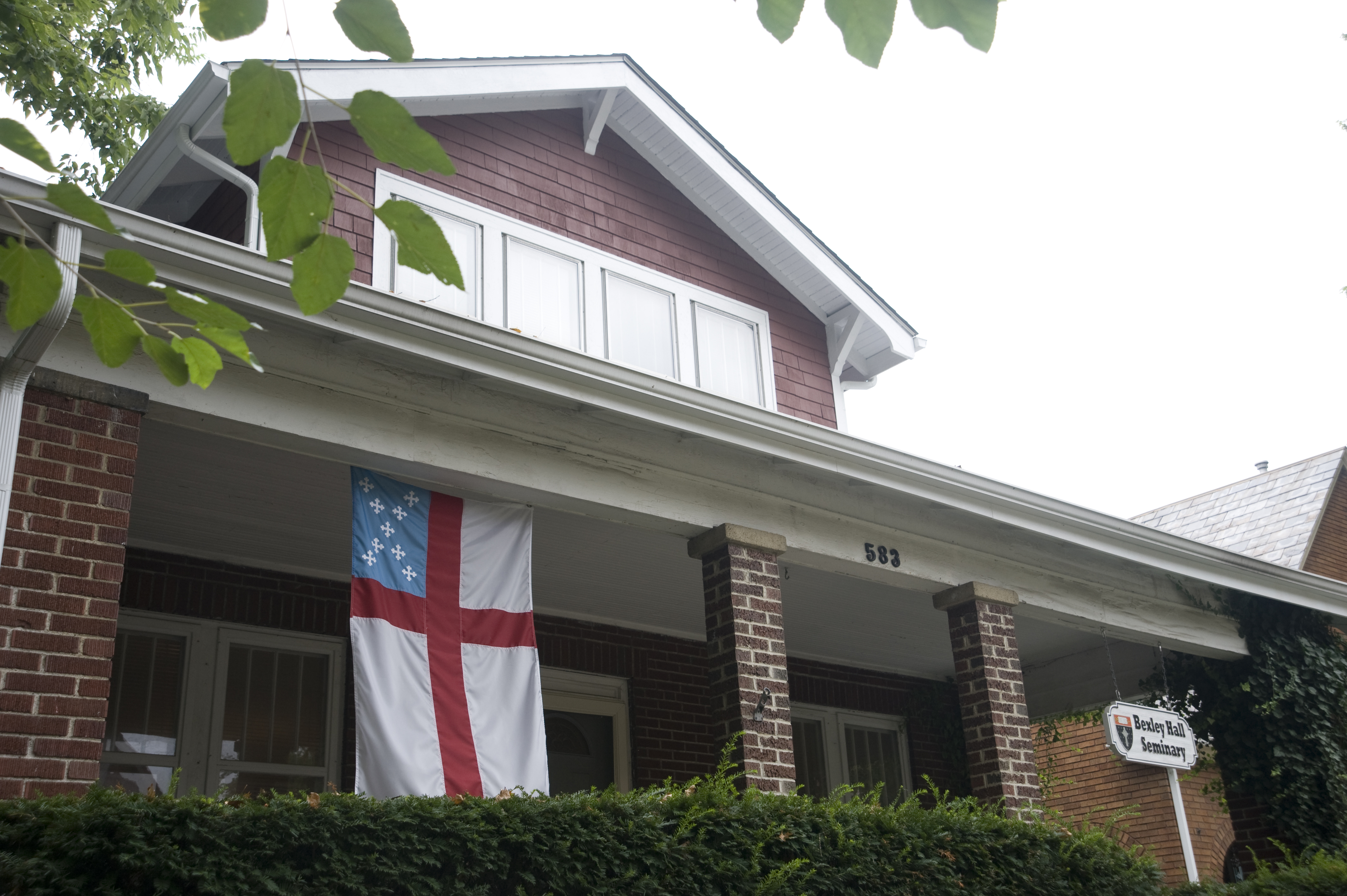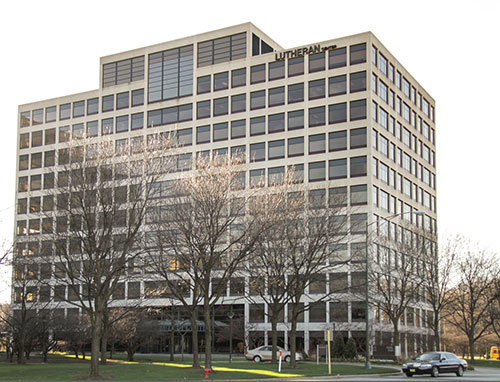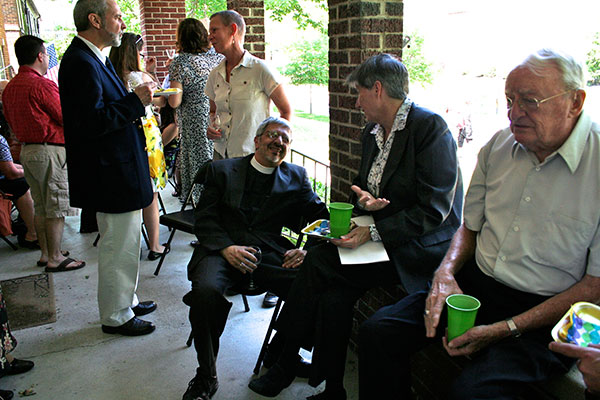 |
Roger Ferlo is the new president of the federation of Bexley Hall and Seabury Western, the Episcopal Church's two smallest seminaries.
Credit: Steve Donisch |
Seabury Western Theological Seminary and Bexley Hall Seminary are the two smallest of the 11 theological schools affiliated with the Episcopal Church. Put them together, as the federation approved in October by their governing boards does, and the combined school is still the smallest theological school in the Episcopal Church.
Despite its diminutive size, however, the federation’s new president, Roger Ferlo, has set a big goal for it. “We should become a model of where theological education should go in this century,” he said in a recent interview.
The decisions taken by the two schools that culminated in the federation were driven in good measure by necessity. Life had been a struggle for Bexley and Seabury for a number of years — both financially and otherwise. Nonetheless, the choice of federation is now seen in both schools as offering considerably more than simply balancing the books and making the most of a bad situation.
Ferlo put it like this in a sermon he preached in October at the annual convention of the Episcopal Diocese of Indianapolis: “In leaving behind the trappings of institutional stability, painful as it has been to do so, Bexley and Seabury have become paradoxically free to rethink everything, including what it means to prepare people for ministry, and to reach out to those people who might otherwise never think that the church had anything to contribute to intellectual or public life. We have been freed to try out new platforms of teaching and learning, and to attract new students and participants — people with no intention of being ordained, and who never thought seminary would have anything to offer them.”
The exploration of a possible collaboration of the schools began in 2007 when Seabury, then based in Evanston, Illinois, put out a tentative feeler to Bexley, which is 350 miles to its east in Columbus, Ohio. At the time, Bexley was winding up a 39-year association with Colgate Rochester Crozer Divinity School in Rochester, New York, to focus entirely on its three-year master of divinity program based at Trinity Lutheran Seminary in Columbus. Meanwhile, Seabury was staring at the prospect of another substantial annual deficit. Dwindling enrollment in its M.Div. program was making it ever more difficult for Seabury to maintain its campus and pay its faculty and administrative staff.
“Bexley will not enter into this without a consultant,” Carlson Gerdau, the Episcopal priest who is co-chair of the Bexley board, recalls saying as his board began to consider the Seabury invitation. Seabury was also eager for external guidance, so together, the schools looked to Auburn Theological Seminary, with its well-established consulting service. In short order they retained the services of Barbara Wheeler, who was then Auburn’s president, and Anthony Ruger, senior research fellow at Auburn’s Center for the Study of Theological Education. Wheeler asked Martha Horne, dean and president emerita of Virginia Theological Seminary, to join the consulting team because of her familiarity with Episcopal seminaries.
Three hundred years of experience
Seabury Western Theological Seminary was created in 1933 as an amalgamation of two schools established in the 19th century, Seabury Divinity School of Faribault, Minnesota, and Western Theological Seminary of Evanston. Just north of Chicago, the combined institution occupied a site adjacent to Northwestern University — in fact, much of its land was leased from Northwestern — and across the street from Garrett- Evangelical Theological Seminary, a United Methodist school, with which it shared one of the nation’s major theological libraries.
 |
| Jo McCulty |
Seabury Divinity School had been founded in 1858 by James Lloyd Breck, a celebrated Episcopal missionary, as part of a university he envisioned as an institution that would educate Native Americans and white settlers from the East side by side. The rest of the school did not survive. Earlier, Philander Chase, the first Episcopal bishop of Ohio, also had envisioned a frontier university when in 1823 he founded Bexley Hall and its companion, Kenyon College, in the Columbus, Ohio, suburb of Worthington. The following year he moved the two schools 50 miles away to tiny Gambier, where Kenyon still thrives as an elite liberal arts college. Chase served as president of Bexley and Kenyon until 1831. (The seminary takes its name from a 19th-century British chancellor of the exchequer, Nicholas Vansittart, Baron Bexley, who, along with his friends Baron Gambier and Baron Kenyon, gave Chase a major chunk of the money necessary to launch the schools.)
On the basis of these 19th-century origins, Ferlo likes to say that the new federation is equipped with “300 years of experience,” but those who carried that experience into the federation were few in number. In 2008, the year after Seabury and Bexley began talking about whether they had anything to talk about, Seabury announced a “financial exigency,” laid off most of its administrative support staff, and put the faculty on notice that tenure was at an end. By the end of the next year, Gary Hall, the dean and president who announced the decision, was gone, and by the time the federation talks had begun in earnest, Seabury’s faculty had shrunk from nine to four. (Hall is now dean of Washington National Cathedral.)
Assess, discern, negotiate
Theological school joint ventures, mergers, and partnerships are difficult to achieve. Robert E. Cooley, the president emeritus of Gordon-Conwell Theological Seminary and a leading expert on theological school governance, reported in a 2009 article in In Trust that of 10 such alliance projects he had then shepherded, only two had concluded with formal consolidations. And while in the last couple of years some consolidations have been achieved—Lutheran Theological Southern Seminary with Lenoir-Rhyne University, Mennonite Brethren Biblical Seminary with Fresno Pacific University, and a few others—at other institutions, recent talks have fallen apart.
Seabury’s reduction in force and its termination of its M.Div. program did much to ease the negotiations between Seabury and Bexley, according to Robert Bottoms, who became the school’s interim president following Hall’s departure. Previously Seabury’s board chair, Bottoms had retired from the presidency of DePauw University in Greencastle, Indiana, in 2008.
“We were both so small,” Bottoms said. “We weren’t trying to merge two large faculties into a smaller whole. We didn’t have to argue over how many people had to be terminated.”
As Bottoms took over the presidency of Seabury, the school was still largely occupied with a discernment process to map its future. Seabury had announced the process as a step toward resolving its financial crisis, but neither it nor Bexley had yet had anything to say publicly about their alliance conversations.
“I spent a lot of time talking to bishops, particularly the bishops of Province V, about their needs,” Bottoms said. Province V, or the Province of the Midwest, encompasses the Episcopal dioceses in Wisconsin, Illinois, Michigan, Indiana, and Ohio. A key need the bishops expressed, he said, was for leadership training for clergy, a topic that had been passed over lightly in the M.Div. curricula most clergy had experienced.
 |
After selling its campus in Evanston, Illinois, Seabury Western Theological Seminary began to rent space in the national headquarters of the Evangelical Lutheran Church in America, near O'Hare Airport in Chicago.
Credit: Phillip Miller |
Concurrent with his needs assessing and with pressing on with the talks with Bexley’s leaders, Bottoms launched the negotiations for selling Seabury’s now-unneeded campus back to Northwestern University.
“Those were the most interesting negotiations I’ve ever engaged in,” he said. “Northwestern, in the person of Gene Sunshine, their chief financial officer, thought it had the upper hand because they owned 90 percent of the land. We thought we had the upper hand because Northwestern urgently needed the buildings we had for sale.”
The negotiations concluded with sale of Seabury’s buildings to Northwestern for what Bottoms described as “just north of $15 million.” The purchase price was payable over several years, but the sale enabled Seabury to retire its debt and set aside money for whatever its future was to be.
Beginning to walk together
At Bexley Hall, leadership had also passed to an interim chief executive. With the departure of John Kevern as dean and president, board member Robert Reber, the retired dean of Auburn Seminary, became president pro tempore. Reber’s leadership further increased the chances of successful alliance negotiations, in Bottoms’ opinion. As Bottoms put it, “Both schools were headed by interims eager to move into retirement.”
Reber conceded that as a member of the joint negotiating committee with Seabury, he had his doubts at the outset “whether this was going to go anywhere.” But over time it became clear to him that the schools’ actual and prospective curricula complemented each other well.
“Bexley had a unique and workable M.Div. program and Seabury came to the table with a strong D.Min. program and a commitment to continuing education, especially for lay people,” he said.
Like Seabury after its sale of its Evanston campus, Bexley owned no property. Instead, it rented a building on the Trinity Lutheran Seminary campus and paid three-quarters of the tuition it received from its students to Trinity in return for Trinity’s providing most of the course work for Bexley students. The small Bexley faculty, currently four, taught Anglican studies and liturgy and supervised Bexley students’ spiritual formation. Bexley’s strong emphasis on spiritual formation, which includes a semiannual student– faculty silent retreat and a requirement that students adopt a rule of life under the supervision of a spiritual director, gives it a distinctive character among theological schools, including Episcopal schools.
With the termination of Seabury’s M.Div. program, the two schools were focused on appealing to differing core student bodies, but their cultures were quite similar. Indeed, they were alike enough to offer “compelling reasons for each institution to consider a closer alliance with the other,” to quote the Auburn consultants’ cautiously worded initial recommendation, which was delivered to the schools in March 2008 but not announced to the public until 2010. Their similar cultures, the consultants said, arose from their common pioneer heritage, their “historic commitment to generous Anglo-Catholicism,” and their sense of service primarily to the Episcopal Church in the Midwest.
The Auburn report accelerated the momentum of the exploration. A dozen trustees, six from each school, accompanied by their chief executives, met in September 2008, November 2009, and March 2010 to draw up a scheme for a common future. At the last of the three sessions, the joint trustee consultation adopted a recommendation that the schools move toward a strategic alliance that would include joint fundraising, unified marketing and recruitment, and unified financial services. The consultation also called for design of possible models of governance.
The recommendation was adopted unanimously by both boards of trustees, meeting separately, in May 2010. Plainly, the two schools were beginning to walk together. More meetings of the joint trustee consultation were scheduled for the summer of 2010, followed by a joint meeting of the boards the following October.
 |
Bexley's front porch offers an informal place to meet the federation's new president, Roger Ferlo, who was formerly the director of the Institute of Christian Formation and Leadership at Virginia Theological Seminary.
Credit: Shannon Ferguson Kelly |
“Every decision was made unanimously,” Reber recalled. “The committee got along so well that every decision came easily, and meetings tended to end early.”
Meantime Bexley moved to assure Trinity Seminary that nothing was in store that would change its collaborative agreement with the Lutheran school, and Seabury acted similarly to confirm that its D.Min. collaboration with Church Divinity School of the Pacific and with the Association of Chicago Theological Schools would remain in place.
Sending a message
The term “federation” had not yet entered either schools’ public vocabulary, but on February 10, 2011, the joint trustee consultation, meeting in Columbus at Trinity Seminary, ratified what was perhaps the central agreement. The two schools would operate as a single unit beginning immediately. On July 1, Bottoms would become interim president of both schools while work would continue on design of a structure for a “permanent partnership,” and Reber would join a committee searching for a permanent president of the combined schools. (One possible benefit of the partnership for Bexley students, currently under exploration, is access to Seabury funds restricted for student scholarships.)
Thirteen months later the boards of the two schools agreed unanimously to “federate,” and they elected Roger Ferlo as president.
“In some ways, once we decided on Roger as leader, many other things fell into place,” said Gwynne Wright, an Episcopal priest who chairs the Seabury board.
“We agreed that his leadership would be critical.”
Ferlo came to the federated schools in July 2012 from Virginia Theological Seminary, the Episcopal Church’s largest and most prosperous seminary. There he was associate dean, director of the Institute of Christian Formation and Leadership, and professor of religion and culture. Prior to his time at Virginia he had extensive experience as a parish priest.
With Ferlo’s arrival, the uniting process accelerated, in October 2012 the two boards, again acting unanimously, agreed to approve the proposed federation structure, a single corporation—Bexley Hall–Seabury Western Theological Seminary Federation—with a single governing board, that would own and operate the school in two locations. To make the uniting easier, and to eliminate the need for negotiating with the donors of perpetual endowment gifts benefiting one or the other of the original schools, the existing seminary corporations would remain as subsidiary “supported organizations” of the federation corporation, with governing boards identical in membership to the federation board. In other words, as needed, the same trustees would convene as the board of trustees of Bexley or Seabury.
“We are sending a message to the larger church,” said W. Michie Klusmeyer, the Episcopal bishop of West Virginia, who is co-chair of the Bexley board. “We can no longer do business in the way of the 1950s. Federations and mutual support are clearly the way forward.”
Formal incorporation of the federation and renewed articles of incorporation for its subsidiaries are expected to be approved at the next meeting of the unified board, scheduled for mid-February 2013, with corporate existence retroactive to January 1. Until then the present boards of the two schools, 43 members in all, constitute the unified board. In the interim, a joint committee is working on the delicate question of the size and membership of the successor board, who will chair it, and how many bishops it will include. In the past, the bishops of Minnesota, Chicago, Ohio, and Southern Ohio have been ex officio members of one or the other of the boards; Bexley currently also has three other bishops on its 23-member board.
Flexible now, specifics to come
Whether or not Episcopal bishops are seated in large numbers on the federation’s new board, their views and their decisions will have a significant impact on Bexley– Seabury’s future. As individual schools, Seabury and Bexley faced shrinking M.Div. enrollments in large part because bishops have been allowing fewer people to proceed along the path toward ordination. (Bexley’s fall 2011 enrollment was only 15.) Despite widespread calls for an increase in “bivocational” clergy—priests who support themselves in nonchurch jobs—many bishops and their dioceses continue to limit their candidates for ordination to numbers for whom they can reasonably expect to provide paid jobs. And the supply of those jobs is shrinking.
How to cope with this phenomenon is one of the issues with which Ferlo must wrestle as he plans his activities in the coming months. Other questions yet ahead: How can the federation best take advantage of Seabury’s existing relationship with Northwestern University’s Kellogg Center for Nonprofit Management? What kinds of education programs for the laity should the federation offer that will meet the current needs of the church and create an income stream sufficient to support them? And many more. Ferlo has chosen to be Chicago-based, with an office at Seabury’s new rented home on the sixth floor of the national headquarters of the Evangelical Lutheran Church of America, which is on Chicago’s far west side near O’Hare Airport. Does the Episcopal federation’s adjacency to ELCA institutions at both its locations open the way to significant new collaborations between the two churches, which are in full communion with each other? That’s another question that has not yet been resolved.
So far Ferlo has stressed the federation’s flexibility and his commitment to launching a new approach to theological education in a new time, but there have been few specifics.
Roger Ferlo is scheduled to be installed formally as president of the Bexley Hall–Seabury Western Federation in April. Among the issues he will need to address: Building and strengthening educational programs that fulfill the federation’s mission, and establishing a financial model to sustain those programs. Looking ahead in a conversation the other day, he said he hopes to lay out a detailed plan for the federation in his inaugural speech.